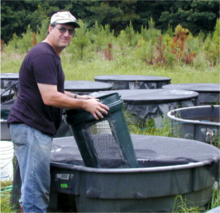Wikinews interviews American zoologists about pirate perches' chemical camouflage
Friday, March 29, 2013

Image: Resetarits Lab.

Image: Resetarits Lab.

Image: Resetarits Lab.

Image: Resetarits Lab.
American zoologists, William Resetarits and Christopher Binckley, have discovered chemical camouflage in pirate perches. The researchers experimented with common predatory fish victims, such as tree frogs and aquatic beetles, which avoid places where fishes live. However these victims didn't avoid pirate perches. On March 7, the American Naturalist published the researchers' paper.
Today, Wikinews interviewed one of the researchers, William J Resetarits, about the study.
![]() ((Wikinews
((Wikinews![]() )) What caused your initial interest in Pirate perches?
)) What caused your initial interest in Pirate perches?
- William J Resetarits: Pirate perch are quite common at our field site in Virginia and we were looking to include as much breadth of diversity as possible in our experiments to see whether the avoidance response we were seeing was a generalized response to fish. So, we used fish that were both phylogenetically and ecologically diverse. Pirate perch are in their own taxonomic family, and represent a different taxonomic order, which includes the Amblyopsid cavefish. So, they have some unique aspects to their morphology and life history, but they are generalist predators and so should have be avoided like all the other fish tested.
![]() ((WN
((WN![]() )) Do you have a photo of a Pirate perch, and of the environment you conducted experiments in (the pools)? What lab were the experiments carried out in?
)) Do you have a photo of a Pirate perch, and of the environment you conducted experiments in (the pools)? What lab were the experiments carried out in?
- WJR: We don't have a great photo ourselves, but there are several available in the public domain. We do have photos of the pools, which I will send.
- WJR: All of the experiments (11 in total) were carried out in the field, rather than in the lab, with natural populations of colonizing organisms. Work was conducted at several sites over the years, including the Duke Zoology Field Station, University of Illinois Experimental Pond Facility, Grice Marine Lab (College of Charleston), Naval Security Activity Northwest (Virginia) and Tyson Research Center (Washington University in St. Louis).
![]() ((WN
((WN![]() )) As far as I could see from the news and Abstract, the prey species avoided pirate perches. What prey species did you test?
)) As far as I could see from the news and Abstract, the prey species avoided pirate perches. What prey species did you test?
- WJR: Over the 11 experiments we have used three species of treefrogs (gray treefrogs, Hyla chrysoscelis, squirrel treefrogs, H. squirrella, and pine woods treefrogs, H. femoralis), as well as a total of about 45 species of Dytiscid and Hydrophilid beetles – the two largest families of aquatic beetles. Quite a diverse group, and obviously the shared ancestor of treefrogs and beetles is quite far back in evolutionary history, so these groups have separately evolved avoidance responses to fish.
![]() ((WN
((WN![]() )) What makes you confident that the camouflage has a chemical nature?
)) What makes you confident that the camouflage has a chemical nature?
- WJR: Well, just to clarify a bit, we use the term camouflage, because it is readily understandable, but what we really are dealing with is some form of "chemical deception". The actual mechanism may be camouflage, which makes an organism difficult to detect, mimicry, which make an organism difficult to correctly identify, or cloaking, in which the organism simply does not produce a signal detectable to the receiver. We are all familiar with visual camouflage, chameleons being a great example, or a deer fawn in the underbrush. Mimicry, flies that look like bees, or harmless snakes that look like highly venomous ones, is also familiar and common. But an organism can't evolve practical invisibility, like Harry Potter's invisibility cloak, or the Romulan cloaking device. However, an organism COULD conceivably be chemically "invisible", either by not producing a signal or producing a second chemical that masks the signal. So, the general term "chemical deception" applies until we tease out the specific mechanism.
- WJR: Because fish cues appear highly volatile, lasting only a few days if the fish are removed, and colonization/oviposition is highly unpredictable in time, we really couldn't simply use fish conditioned water. So, in our early experiments, we went to considerable pains to isolate the fish in terms of visual and movement cues, so that only chemical cues were available. Sound production is rare in fishes, and none of the fish tested are known to produce sounds. We placed fish inside 115ℓ opaque plastic trash cans with opaque lids and each can had two 25x50 cm sections on opposite sides (and entirely below water-level) removed and replaced with one layer of 99% shade cloth over one layer of no-see-um netting (<1 mm x < 1mm mesh). When submerged in larger tanks light penetration was essentially zero and motion cues were eliminated, but water (and chemical cues) were exchanged.
![]() ((WN
((WN![]() )) What equipment was used during the study? Do you have photos?
)) What equipment was used during the study? Do you have photos?
- WJR: This is pretty simple stuff, from the perspective of equipment. Not much fancy "science gear" involved. We use cattle tanks or kiddie wading pools, window screen, aquarium nets and turkey basters to collect beetles and eggs, and then dissecting microscopes to identify beetles. The "rocket science" part of it comes in the careful experimental design, the meticulous set up of the experiments and data collection, and then the analysis. Of course, our current work trying to identify the active compound(s) in fish kairomones (odor) uses much more sophisticated analytical equipment.
![]() ((WN
((WN![]() )) What were the roles of the people involved in the research? What activity was most time-consuming?
)) What were the roles of the people involved in the research? What activity was most time-consuming?
- WJR: Across the entire 11 experiments, Chris and I did the bulk of the work, along with help from a variety of field assistants and grad students along the way, particularly Joe Rieger and Dave Chalcraft, who also contributed data to the paper.
- WJR: This is VERY tedious work. Setup of the experiments is tough physically, and quite elaborate and time consuming, but the toughest part was collecting the frog eggs and beetles, which involves long hours bending over tanks in the hot sun. Counting eggs also takes considerable time, but the most time consuming aspect was sorting and identifying beetles, which was done by Chris and Joe with help from folks at the Smithsonian.
![]() ((WN
((WN![]() )) How do you plan to investigate the chemistry of the phenomenon? How would you like to check what exactly happens?
)) How do you plan to investigate the chemistry of the phenomenon? How would you like to check what exactly happens?
- WJR: We are using an approach developed by my current post doc, Alon Silberbush, who identified and characterized the kairomone produced by a predatory insect Notonecta. This process involves chemical analysis using gas chromatography. We have an advantage over others who have tried unsuccessfully to identify fish kairomones because we essentially have a control – a fish (pirate perch) that does everything a fish does, but does not "smell" like a fish. So, we can use chemical differences between pirate perch and other fish to guide us in identifying the active compounds in fish kairomones, as well as the mechanism of chemical deception in pirate perch.
- WJR: Once we have identified candidate compounds, we then take it back to the field to test with the same organisms which alerted us to the phenomenon originally, treefrogs and beetles, as well as other organisms known to respond to fish chemical cues, such as mosquitoes and water fleas (Daphnia). This allows us to iteratively verify that we have the right compound(s), as well as further test the generality of the response to fish and the chemical deception of pirate perch. We will also test whether this chemical deception works against the pirate perch's own predators.
- WJR: Of course, other critical questions that we are working on include just how much advantage in terms of prey acquisition do pirate perch gain as a result of chemical deception, does this phenomenon occur in closely related species, like the cavefish, and are there prey species that have found a way around the chemical deception? There is lots to do and I think we have just scratched the surface.
Sources
- William J Resetarits, Christopher A. Binkley. "Is the pirate really a ghost? Evidence for generalized chemical camouflage in an aquatic predator, pirate perch Aphredoderus sayanus" — The American Naturalist, March 7, 2013
External links
- "William J Resetarits homepage" — April 5, 2013 (date of access)








